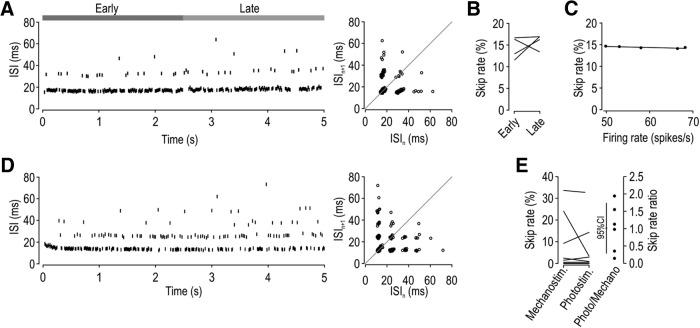Figure 8.
Propagation failure rate is independent of stimulus modality. A, Integer-multiple-patterned spiking in the same neuron illustrated in Figure 7, but now stimulated optogenetically with 2 mW/mm2 blue (455 nm) light applied to the hindpaw, which evoked 52 spikes/s. Corresponding ISI return map is shown. Based on all responses from the unit shown in A, (B) the skip rate did not differ significantly between early- and late-phase responses (t(3) = −0.83, p = 0.47, paired t test) and (C) the slope of the regression line did not differ significantly from horizontal (slope = −0.022, p = 0.10, one-sample t test). D, Sample of optogenetically evoked spiking in another unit. Because of the high skip rate, ISIs with >1 consecutively skipped spike and consecutive ISIs with skipped spikes are evident. E, Based on analysis of 10 units responsive to mechanostimulation and photostimulation, there was no significant difference in the skip rate between stimulus modalities (Z = −0.31, p = 0.84, signed rank test) (left). The skip rate during photo- and mechano-evoked spiking expressed as a ratio (right) did not differ significantly from unity (t(5) = 0.038, p = 0.97, one-sample t test) but did differ significantly from zero (t(5) = 3.60, p = 0.016). The 95% CI is shown. Overall, these data argue in favor of skipping due to intermittent failure of spike propagation, and against skipping due to intermittent failure of spike initiation.

